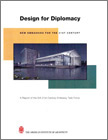|
Design Excellence illustrates how civic architecture integrates security, sustainability, and energy efficiency in high-performance buildings, while providing the best value to taxpayers.
EMBASSY DESIGN EXCELLENCE

Design for Diplomacy: New Embassies for the 21st Century (PDF)
As iconic symbols of American diplomacy, U.S. Embassies serve various functions. The ongoing threats to Americans who live and work in overseas diplomatic facilities impact the security, design, construction, and operations of these buildings. Sustainable design practices and operations effectively reduce the consumption of resources at diplomatic facilities, while enhancing security.
In 2008, the U.S. Department of State asked Ms. Nadel and the American Institute of Architects (AIA) to lead an effort to examine embassy design. As chair of the AIA 21st Century Task Force, Ms. Nadel assembled a multi-disciplined group comprised of leading architects, engineers, landscape architects, ambassadors, diplomats, Foreign Service personnel, architectural historians, public art experts, and key members of the Department of State Bureau of Overseas Buildings Operations (OBO).
Ms. Nadel authored the Task Force report, Design for Diplomacy: New Embassies for the 21st Century (AIA, 2009), which contains the Task Force recommendations about improving ways embassies are planned, designed, and built, with the goals of integrating safety and security, sustainability, and energy efficiency. Additionally, functional work spaces, accessibility, historic preservation, user productivity, operations, and maintenance were addressed.
Based on the Task Force findings and the Design for Diplomacy report, in April 2010, OBO announced the development of a new Design Excellence program. At the April 2011 Industry Advisory Panel meeting in Washington, D.C., OBO formally announced the adaption of Design Excellence, after a year of internal study and working groups. OBO’s Acting Director, Adam Namm, acknowledged Ms. Nadel for her leadership on the Design Excellence Task Force and the Design for Diplomacy report, which formed the basis of OBO’s Design Excellence initiative.
DESIGN EXCELLENCE NEWS
“2011 AIA Convention: Federal Government Carries the Sustainability Torch,” e-Oculus, by Matt Shoor, May 25, 2011.
“Design Excellence Initiative Driving Next Generation of Embassies,” AIArchitect, April 29, 2011.
“State Department to Roll Out new Embassy Design Excellence Initiative April 26,” AIA, April 22, 2011.
“AIA Members Brief Congress on Embassy Design,” The Angle, March 31, 2011.
“Secure and Sustainable U.S. Embassies-Briefing,” AIA, March 29, 2011, House Briefing before the High-Performance Building Congressional Caucus Coalition
"AIA Calls on State Department to Integrate Security and Design Excellence," AIArchitect, July 24, 2009
"Sen. Kerry Commends AIA Call on State Department to Integrate Security and Design Excellence," The Angle, Vol. 7, Issue 15, July 16, 2009
"Sen. Kerry Commends AIA Call on State Department to Integrate Security and Design Excellence," AIA, July 9, 2009
RESOURCE
CONGRESSIONAL BRIEFING ON EMBASSY DESIGN
Ms. Nadel was invited by the AIA and the High-Performance Building Congressional Caucus Coalition to address a Congressional Briefing. The purpose of the briefing was to educate members of Congress and their staff about sustainable building initiatives at U.S. Embassies and how integrating sustainability and security result in design excellence.
“Secure and Sustainable U.S. Embassies-Briefing,” AIA, March 29, 2011, House Briefing before the High-Performance Building Congressional Caucus Coalition
“AIA Members Brief Congress on Embassy Design,” The Angle, March 31, 2011.
CONGRESSIONAL TESTIMONY ON FEDERAL SECURITY STANDARDS
Ms. Nadel was invited by the Chair of the House Subcommittee on Economic Development, Public Buildings and Emergency Management to testify before Congress about Federal security standards applicable to public buildings. The hearing focused on the public policy and financial implications of having two different sets of security standards for leasehold acquisitions undertaken by the General Services Administration (GSA) in urban and suburban-based space procurements. Ms. Nadel represented the American Institute of Architects.
“Too Much for Too Little: Finding the Cost-Risk Balance for Protecting Federal Employees in Leased Facilities”
House Subcommittee on Economic Development, Public Buildings and Emergency Management, May 2010.
Testimony By Ms. Barbara A. Nadel FAIA
Principal, Barbara Nadel Architect
Representing the American Institute of Architects (AIA)
Written testimony:
Google Docs
PDF
Media Coverage of Testimony
“Security design cannot be one size-fits-all,” Architecture and Design (Australia), June 2, 2010
“Flexibility is Key When Evaluating Security Solutions in Government Buildings, Says AIA Exec,” Security Magazine, May 20, 2010
“Flexibility is Key When Evaluating Security Solutions in Government Buildings, AIA’s Barbara Nadel Testifies. Each Building is Different and Presents Different Security Challenges,” AIA, May 20, 2010.
“AIA Member Testifies Before Congress on Building Security,” The Angle, AIA, May 20, 2010
|

